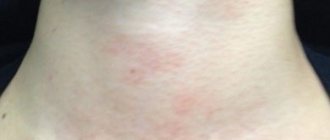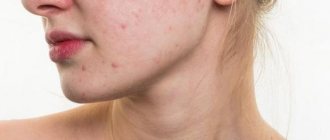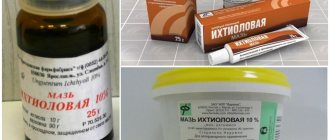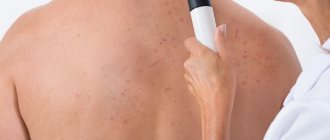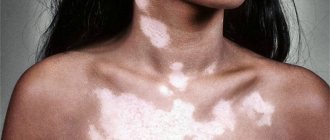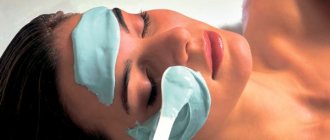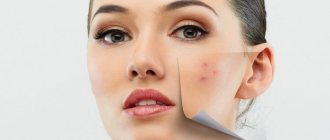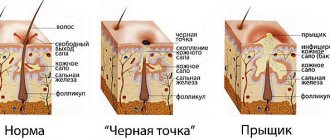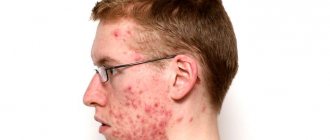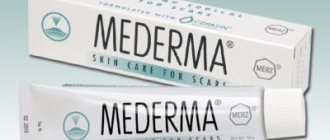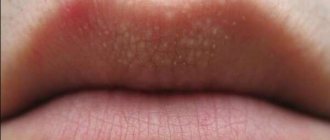Inflamed spots on a child's back, bumps and blisters, blisters filled with liquid - a rash on a child's back is expressed depending on the specific problem. Usually the rash has strict localization boundaries: only on the shoulder blades, upper torso, lower.
An important difference between the onset of allergic reactions is the absence of fever; infectious pathologies are characterized by chills or fever.
Why does a child get a rash and how to get rid of it? Only useful facts.
General information: what is a rash?
Rashes are elements of any size that affect the skin or mucous membranes under the influence of various pathological changes in the body. The rash varies in color, structure and general appearance. Among the primary (initial) types, doctors distinguish the following.
- Nodules (papules) are swellings, the diameter of which varies from 1 mm to 3 cm. The tubercles can be palpated.
- Pustule (ulcer) – the element contains pus.
- Blister - pink, cavity-free elements. The difference is the unbearable itching.
- Spots are local changes in the top layer of skin.
- Bubbles (sizes greater than 0.5 cm). Inside the element there is serous fluid.
- Hemorrhage - points that appear after subcutaneous hemorrhage. The group also includes spots similar to lichen.
Reference! Secondary rash appears as complications after the primary one. These are scars, abrasions, atrophy of a skin area, scales, erosion or ulcer.
Red spots on the skin
Every person has had strange spots on their skin at least once. Red spots appear for many reasons. However, they can be a slight irritation and indicate a deadly condition. If changes in the skin are observed along with fever, swelling, pain, itching, then it is important to seek help in time.
- Allergies to foods, sunlight, household chemicals, medications.
- Dermatitis.
- Lack of vitamins (seasonal).
- Low immunity.
- Infections.
- STD.
- Stress.
Rash due to illness
People, especially men, do not always pay attention to changes in skin tone in certain places. The reason for their appearance may be various factors. It is important to diagnose a provocateur. By eliminating it, the stains will also disappear. In the stronger half of humanity, red marks are more often associated with the following “pathogens”:
- Poor nutrition, frequent snacking.
- Allergy.
- Stress, nervous tension.
- Alcohol, smoking.
Finding out the main reasons
Spots on a child's back are not always a sign of a specific disease. In some situations, a rash appears due to negative environmental factors. The body's response to the action of allergens and failure to comply with hygiene measures are common situations for children from one year to 7-9 years. If red spots on the child’s back do not go away, cause discomfort and accompanying symptoms are observed (fever, general weakness), contact your pediatrician immediately.
The list of possible reasons:
- Chickenpox;
- Measles;
- Bacterial sepsis;
- Meningitis;
- Lichen.
Common cause of the problem
One of the most common factors that provoke the appearance of rashes is prickly heat. This is a harmless small rash on a child’s back, which is caused by overheating of the body, high levels of humidity, and insufficient hygiene. The mechanism of appearance is associated with blockage of the sweat glands.
Differences between spots on a child's back
After returning from a walk, did you notice that your child’s back is red? This is a sign that you are not dressed for the weather, your skin is sweaty and prickly heat appears. You can get rid of it by washing and thoroughly drying the rash areas (it is also recommended to lubricate them with a drying cream - Sudocrem). Prevention – absence of overheating and profuse sweating. When going outside, dress your baby in clothes that are easy to take off. Miliaria is not dangerous to health and is not contagious to others.
Allergic dermatoses
The majority of all back lesions are caused by various types of allergic dermatosis. In children aged 1 to 4 years, the rash is most often caused by the following reasons.
- Atopic dermatitis (diathesis or infantile eczema). The pathology affects the face, buttocks and limbs.
- Strophulus - urticaria with the development of papules on the skin.
- Exudative diathesis. The acute severity of the exacerbation period persists for up to 2 years.
- Dermatitis, which is transmitted by contact.
The allergic form develops through direct contact of the body and the allergen (with a single repetition or with regular exposure). A pathological reaction develops due to sensitization of the body to the composition of a certain substance. Sensitizers most often are components in plants, animal antigens, chemical compounds, infections, and some products. Contaminated water and the environment also have an impact.
The contact form is manifested by the appearance of rashes on the area of the skin that comes into contact with the allergen. For example, on the back due to rough clothing or an unsuitable bathing sponge. Characteristic symptoms: itching, redness, swelling of the spots. If left untreated, the skin on the back becomes rough, crusty, and loses sensitivity.
Chickenpox familiar to everyone
Chicken pox (the causative agent belongs to the group of herpes viruses) is another reason why red spots appeared on the child’s back. Small blisters filled with clear exudate form on the skin. They quickly burst and a crust remains in their place.
Reference! A characteristic feature of chickenpox is its long duration. From the infection stage to the appearance of the first spots, it takes from 10 to 22 days. The rash continues for a week, the crusts persist for another 15-20 days.
Chickenpox in children
Lubricating with brilliant green or a dark solution of potassium permanganate is a prerequisite for stopping the infectious focus. Processing should be continued until the crust is completely separated. You need to lubricate the stains at least 12 times a day. Don't forget that the disease is contagious. The peculiarity is that it can be repeated once (you don’t get sick twice).
Characteristic signs of scarlet fever
Acute preceding symptoms are typical for the disease. Before the rash appears, the child may have a fever, a feeling of nausea and subsequent vomiting. There is also redness and sharp pain in the tonsils, and a headache. The skin turns red, becomes dry and rough.
The ways of transmitting scarlet fever are direct communication with the patient or the use of one object. The disease appears 6-10 days after infection. This is a bacterial pathology, which is expressed by the following symptoms:
- A small scarlet rash on the child’s back;
- The tongue is raspberry-colored;
- General weakness of the body.
The causative agent is hemolytic streptococcus. The rash is first localized in the armpits and neck, then moves to the back. When you touch the skin, it feels like fine sandpaper.
What is the expression of vesiculopustulosis?
When the disease occurs, small pimples containing pus appear on the baby’s back. These spots are on the child’s back, worsening after a shower - so bathing the baby during this period is prohibited. The rash can also affect the arms, legs and even the head. When the blisters burst, they damage adjacent healthy skin and the infection spreads throughout the body. To prevent infection, pustules should be treated with a swab soaked in alcohol. Then cauterize them with a solution of brilliant green or manganese.
Signs of rubella
If there is a pathogen in the body, the rash is detected immediately. Locations: back, legs, neck, head. How does the pathology manifest itself? A small pink rash forms on the skin, which frightens parents due to the area it occupies. Among the accompanying symptoms is an increase in body temperature, as with acute respiratory infections. The disease is typical for children of different ages: from several months or more.
Signs of rubella in a child
Why do white spots appear?
Many representatives of the fair sex want to get a chocolate tan. For this, they are willing to spend hours under ultraviolet rays or go to a solarium, while few people think about the danger this poses.
Of course, girls with this approach will tan, but after tanning, white spots often appear on their backs, which significantly spoil their appearance. An open T-shirt, visiting the same beach and similar places are already becoming questionable.
White patches on the back are the dominant symptom of vitiligo. This pathological condition appears due to a deficiency of cells that produce melanin.
Interesting fact: the disease has been known since ancient times. In Rus', among the common people it was called “dog”. This may be due to the appearance of the sick person.
People are not born with this disease. An abnormal process in the body is formed under the influence of a combination of negative factors. Rarely, the disease occurs before the age of 10. At the moment, scientists have not come to a consensus whether ultraviolet rays are a provoking factor or not.
Factors leading to the development of vitiligo:
- Autoimmune disorders. In this case, there is a disruption in the activity of the immune system, as a result of which the immune system begins to fight the body;
- Genetic predisposition. This does not mean that the disease is directly inherited and will definitely manifest itself in the child if the mother or father has a history of such a problem. Scientists note that a certain chain of genes is transmitted, which can trigger abnormal processes in the body;
- Violation of the trophism of the skin, endocrine disorders;
- Impaired liver function;
- Taking certain medications.
In fact, almost any negative factor can lead to the development of a disease. It is impossible to predict this. The pathology is difficult to correct medically, since it has not been sufficiently studied.
However, there are effective conservative techniques that can reduce the severity of white spots on the back and prevent the appearance of new spots. Treatment is prescribed only by a doctor.
List of other reasons
Spots similar to lichen (they do not itch and do not cause noticeable discomfort) are a possible manifestation of a special form of pathology. This is Zhiber's pink lichen, which is characterized by the primary formation of a maternal plaque. A bright red spot (3-5 cm in size) appears on the back and rises slightly above the skin. In the center of the formation, slight peeling is visible. After 1-2 weeks, active formation of secondary plaques occurs, which are smaller in size.
Another cause of such spots is seborrheic dermatitis. The reason for the development is the increased production of sebum and the active development of microflora against this background. Yellow and pink spots and plaques of various shapes (round, elongated, with clear boundaries) appear on the back. At the site of pathological foci, redness, swelling, crusts and cracks on the skin become wet. A possible complication is a purulent inflammatory process.
What else causes lichen-like spots?
- Deprive yourself. It is characterized by a small rash and the formation of ulcers. These symptoms indicate that there is a fungus in the body. Antibacterial agents for treatment are prescribed by the doctor. The disease is contagious to others.
- Meningitis. This is a dangerous pathology, the list of serious consequences of which even includes death. The reaction to the formation of a small rash, which is a consequence of subcutaneous hemorrhages, should be immediate.
- Measles. Symptoms are rash and high fever. The child’s eyes also become red, the mucous membranes become inflamed, and he suffers from a runny nose and cough. The rash is bright red. Measles is a dangerous disease in which an ambulance should be called immediately. The list of complications includes chronic diseases (bronchitis, pneumonia).
What are age spots and what do they look like?
Normally, melanin is synthesized in the epidermis - the main pigment that gives color to the skin, hair and iris of the eye, and protects the body from exposure to ultraviolet radiation. When melanin production is disrupted, pigment spots form on the skin - areas with an increased or increased concentration of this pigment. Typically, pigment spots are oval or round in shape, and the color can vary from dark beige to dark brown and even black. There are several types of age spots that appear on the back:
- freckles. They often form on the face, arms, shoulders and upper back. They are located in large groups, they are able to independently appear (in spring) and disappear (in autumn and winter), details here.
- moles (nevi). They can be either small (1-2 mm) or quite large (sometimes reaching 3-4 cm or more). The danger of nevi on the back lies not only in the fact that there is a risk of their degeneration into a malignant tumor, but also in the fact that moles can be susceptible to mechanical influences: friction in contact with clothing, compression. Such exposure increases the risk of injury, which can lead to bleeding.
- chloasma. These are clearly defined pigment spots that can be located in groups and change color (become darker) when exposed to UV rays.
- lentigo. There are 3 types: senile, solar and juvenile lentigo. The pigment spots in this case are large and located singly.
- lichen versicolor. This type of pigmentation is characterized by the appearance of small foci that can merge with each other.
Only a dermatologist can accurately determine the type of pigment spot and choose the right treatment. Therefore, if one of the types of hyperpigmentation appears, you should urgently seek medical help.
What you need to know about treatment: notes for review
The main rule that parents need to remember is not to touch or treat the spots with any coloring agents until examined by a pediatrician. Zelenka, potassium permanganate and other solutions will complicate the diagnostic process.
Prickly heat on a child’s back is the most harmless situation on the list of possible ones. The best prevention is keeping it clean and following simple hygiene rules. To eliminate the symptoms, the doctor prescribes medicinal ointments. It is also advisable to treat the skin with folk remedies at home. But such therapy is allowed only after receiving permission from the attending physician.
- Therapeutic bath with the addition of extracts of medicinal herbs (chamomile, calendula, string).
- Treating the skin with drying agents (baby powder is optimal).
- Clothes for a child should be made from natural fabrics (allow the skin to breathe).
Important! For prickly heat, it is forbidden to use brilliant green, iodine and other similar substances.
Proper nutrition and minimizing the effects of irritating factors (limit contact with household chemicals and animals) will help reduce the risk of developing allergic reactions. To treat a mild form, the doctor prescribes moisturizing creams (Fenistil-gel), and to maintain the body’s strength - smecta, activated carbon.
What is it and features
Pigmentation on the back appears as brown, beige or dark yellow growths. Such spots can be localized on the shoulders or fill the entire area of the back along the spine.
The appearance of smooth brown growths is associated with melanin, a pigment in the human body. Its function is to create a barrier against ultraviolet radiation. When sunlight hits the skin, melanocytes are activated and begin producing melanin. Thus, a tan appears. If pigment production fails, brown spots form.
To summarize: what is important to remember?
The variety of possible diseases requires specific and special treatment options. Chickenpox should be treated by smearing the spots with brilliant green, and it is not recommended to remove the crusts yourself (scars will remain on the skin). Roseola does not require specific therapy; it only eliminates the symptom - lowering the temperature.
In case of measles, it is necessary to admit the child to a hospital, since the disease threatens complications (up to meningoencephalitis). For scarlet fever, hospitalization is also indicated. Vaccination against rubella is recommended and is given up to 1 year of age.
If you find spots, blisters of pimples on the back, you should not squeeze pus out of them, allow the child to touch and scratch them, or open the pustules. This may lead to extensive infection (affecting the treatment process). Photos with explanations of the causes and corresponding symptoms can be found on stands in the children's clinic or on the Internet (it is important to go only to trusted sites).
Various rashes on the baby’s back are the first sign of changes inside the body. This may be a response to an irritant, or a symptom of a developing disease. Some rashes do not require treatment, while others require hospital treatment. Do not neglect your child’s health and be sure to consult a doctor. Remember that timely diagnosis and assistance are the key to a quick recovery.
Reasons for neoplasms
Spots on the back can appear at any age of a person, as well as for a variety of reasons. Freckles and moles are harmless formations. But harmless pigmentation can also disguise other rashes on the body that can cause certain concerns.
Due to hormonal imbalances, the production of melanin pigments is disrupted. The consequence may be the appearance of unusual spots on the body. Brown rashes can be observed by women during pregnancy or menopause. In older people, such spots appear as a result of skin aging. Pigment spots may also appear on the back due to a lack of essential vitamins in the body. A person’s genetic predisposition and the characteristics of their skin also play a big role.
If the rash is just a cosmetic defect, it can be removed in a beauty salon or at home using special salon procedures or home remedies. But if the manifestations formed during the period of any disease, it is necessary to first find out the cause of pigmentation, and then select a way to combat the disease. To do this you need to visit a doctor.
Diagnosis and treatment
The cause of the rash is determined by a specialized doctor. As a rule, a visual examination first follows, then tests and additional examination are prescribed. It is useless to describe the rash in words or in correspondence - it is impossible to make a diagnosis in this way, just like on your own. Therefore, if “unhealthy” spots appear on the skin, you need to make an appointment with a dermatologist. If there is a suspicion of a skin pathology, it may additionally be recommended to take a scraping from the affected area for further examination.
Treatment of rashes should be under the guidance of a physician. His task is to prescribe effective and appropriate therapy. In cases of chickenpox, measles and rubella, there is no need to take a course of antibiotics.
If we are talking about a rash due to the presence of scabies mites, then the treatment will be simple. Rashes of an allergic nature require taking samples and prescribing treatment to eliminate the pathogen. Non-infectious skin diseases do not go away on their own; proper treatment is required, taking into account all the characteristics of the body.
Any spot of unknown origin on the body should be shown to a dermatologist if there is cause for concern. Do not voluntarily take medications not prescribed by a doctor. If treated incorrectly, there is a risk that the disease will worsen and then more serious treatment will be required, including hospitalization.
